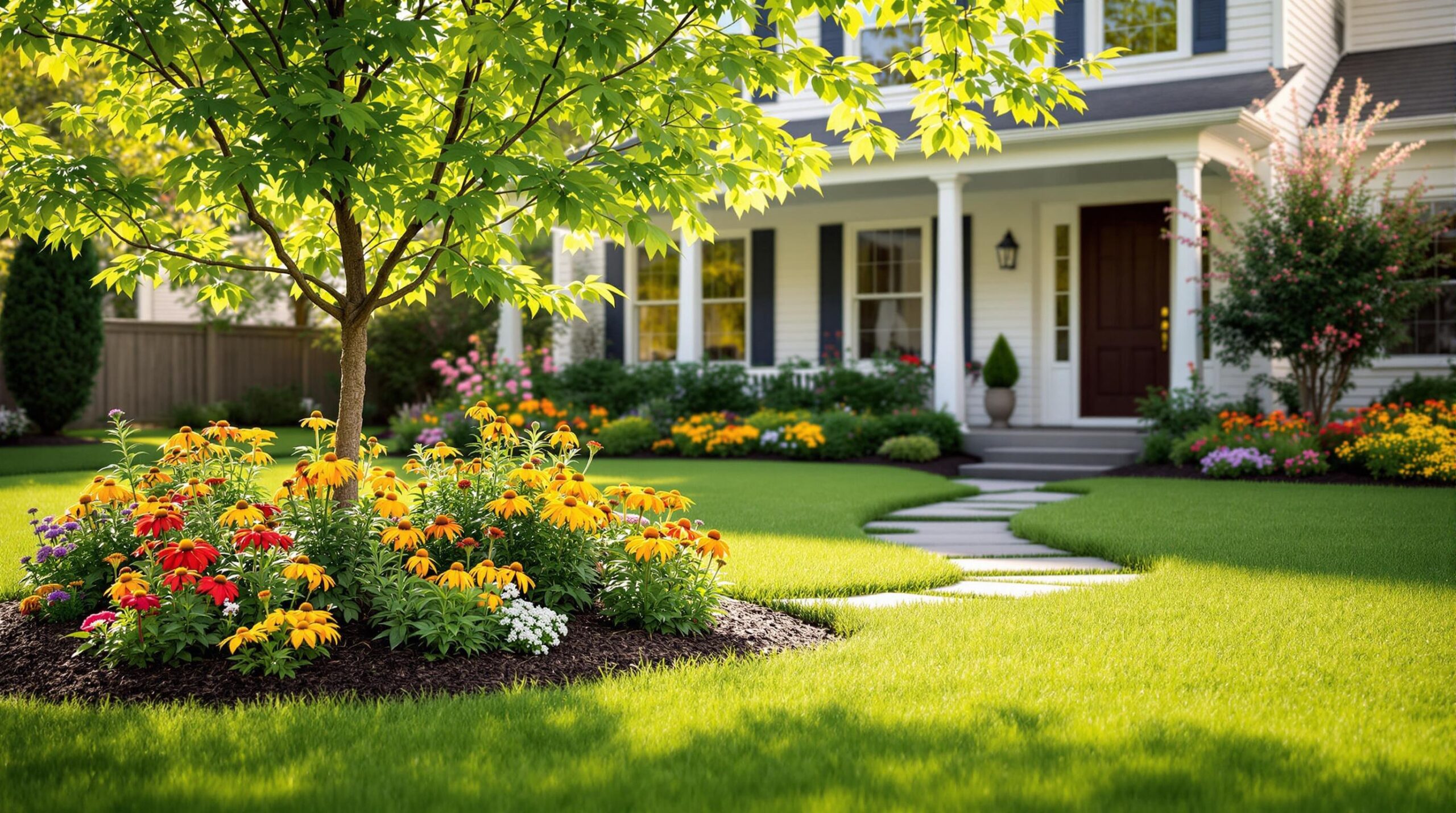- bhavya gada
- No Comments
Spring in Maryland means it’s time to prepare your yard for the season. Here’s a quick guide to get your landscaping in shape:
- Clean Up: Remove winter debris like branches and leaves to prevent pests.
- Fix Lawn Damage: Repair bare patches, aerate soil, and address water pooling.
- Test and Improve Soil: Adjust pH, add compost, and fertilize for healthy growth.
- Prune Trees and Shrubs: Remove dead branches to encourage new growth.
- Refresh Mulch: Lay 2–3 inches of fresh mulch for moisture retention and weed control.
- Plant Native Species: Choose plants suited to Maryland’s climate for easier care.
- Lawn Care: Overseed, fertilize, and mow properly to maintain a lush lawn.
- Solve Drainage Issues: Install systems like French drains to manage spring rains.
- Add Outdoor Features: Consider patios, fire pits, or stone steps for usability.
- Control Weeds Early: Use mulch and pre-emergent herbicides to prevent weeds.
Start with cleanup, then tackle drainage, planting, and mulching. For complex tasks like grading or hardscaping, consider professional help. Maryland homeowners can use these steps to create a vibrant, functional yard this spring.
All 10 Spring Lawn Care Steps // In Order
1. Clean Up Your Yard
As spring begins, remove fallen branches, dead leaves, and any leftover debris from winter. This helps prevent pests and promotes healthy growth. Once your yard is cleared, focus on fixing any damaged spots in your lawn.
2. Fix Damaged Lawn Areas
Check your lawn for compacted spots or areas where water tends to gather. To repair bare patches, start by clearing any debris, loosening the soil, and adding a thin ¼" layer of topsoil. Spread Maryland-blend grass seed early in the spring, then water daily until new grass begins to grow.
If you notice water pooling that doesn’t go away, it might be time to bring in professionals. They can help with:
- Yard leveling and grading
- Installing drainage systems like French drains or swales
Finally, test your soil and make any necessary adjustments to give your seedlings the best chance to thrive.
3. Check and Fix Soil Quality
Once you’ve tackled bare patches and adjusted the grading, it’s time to focus on your soil:
Start by testing the soil’s pH and nutrient levels. You can use a home testing kit or contact your local county extension office for assistance. If the pH is too low, add garden lime to raise it. If it’s too high, use elemental sulfur or organic materials to bring it down. Incorporate organic compost and a slow-release, balanced fertilizer to enrich the soil. For compacted or poorly draining areas, aerate the soil and mix in compost to improve airflow, drainage, and root growth.
4. Trim Trees and Shrubs
Once you’ve taken care of the soil and grading, it’s time to focus on trimming trees and shrubs.
Start by cutting away dead branches and shaping overgrown areas. This helps minimize storm risks and encourages healthy growth in the spring.
Look for signs of trouble, like brittle twigs, missing buds, or peeling bark. These are indicators of dead or diseased wood, which should be removed first to allow the plant’s energy to focus on healthier growth.
When shaping shrubs, aim to enhance your landscape design without over-pruning.
For large limbs or more complex tasks, consider hiring Pro Landscapes MD’s garden and tree services for professional and safe care.
5. Add New Mulch
After pruning trees and shrubs, remove any old, compacted mulch using a rake. In early spring, lay down a 2–3-inch layer of new mulch in garden beds. This helps the soil hold moisture, keeps the temperature steady, and reduces weed growth.
6. Choose Maryland Native Plants
Once your beds are mulched, it’s time to pick the right plants. Native plants in Maryland are well-suited to the local soil, help native wildlife, and require less water once they’re established.
To make the best choices, think about your yard’s specific conditions:
- How much sunlight the area gets (full sun or shade)
- The type of soil and how well it drains
- Space available for the plants to grow to their full size
Group plants with similar sunlight and water needs together (a method called hydrozoning). This approach saves water and makes maintenance easier.
Need help? Reach out to Pro Landscapes MD for advice and professional installation.
sbb-itb-843f8be
7. Start Regular Lawn Care
Once your beds are mulched and plants are set, it’s time to focus on your lawn. Fill in thin patches by overseeding and use a balanced fertilizer tailored to your soil’s needs. Set your mower to a height of 3 inches and stick to a weekly schedule. Avoid cutting off more than one-third of the grass blade length. For watering, aim for about 1 inch per week, preferably in the early morning for best results.
8. Fix Water Flow Problems
Once your turf and garden beds are in good shape, it’s time to check how water flows through your yard.
Spring rains in Maryland can cause flooding, erosion, and damage to your landscaping if drainage isn’t handled correctly. After a rainstorm, walk around your yard to spot areas where water pools or where soil is being washed away.
To address these issues, consider adding French drains, berms, swales, or box-and-pipe systems. You might also need to regrade low spots to guide water away from problem areas. Tackling drainage problems early can save you from expensive repairs later. If you’re unsure of the best solution, it’s a good idea to consult a professional for advice and proper installation.
9. Add Outdoor Living Features
Once you’ve addressed grading and drainage, consider enhancing your yard with features that improve both its appearance and usability.
Start with a stone or paver patio as the centerpiece. These durable materials hold up well against Maryland’s spring rains and summer heat, creating a sturdy and stylish base for outdoor furniture and gatherings. Options like flagstone bring character, while modern pavers allow for versatile designs.
You could also include a fire pit for cozy nights, retaining walls that double as seating and help with erosion, or stone veneer accents to add a touch of elegance.
For yards with varying elevations, natural stone steps can improve access while adding visual appeal. Be sure to choose materials and drainage solutions that can handle seasonal weather changes.
These upgrades not only enhance your yard’s look but also make it a functional space to enjoy from spring through fall.
10. Keep Weeds in Check Early
Spring is when weeds grow fast, so taking action now can save you a lot of hassle later. The key is to stop them before they take over your garden beds or lawn.
Keep a 2–3" layer of mulch (as mentioned in Tip 5) to block weeds from sprouting. For any weeds you see, pull them out by hand, making sure to get the entire root to stop them from growing back. You can also use a pre-emergent herbicide – just follow the label instructions carefully. Tackling weeds early means less time spent battling them in the future.
Pro Landscapes MD Services

Looking to get your Maryland yard in shape for spring? Pro Landscapes MD specializes in full-service landscaping designed specifically for the region’s soil and weather conditions.
Their services cover everything from lawn restoration and soil pH adjustments to drainage fixes, hardscaping, and professional tree care [1]. Whether it’s preventing spring flooding or improving your outdoor space, their team works to keep your landscape in peak condition through Maryland’s seasonal shifts [2].
Pro Landscapes MD proudly serves Howard, Montgomery, and Baltimore counties, preparing your yard to handle spring’s unique demands.
[1] Pro Landscapes MD offers a range of lawn care services, including seeding, fertilizing, and expert pruning for gardens and trees to promote healthy, lush landscapes.
[2] Their drainage solutions include French drains, land grading, dry riverbeds, and stormwater management systems to help prevent flooding and erosion.
Next Steps
Start planning your spring projects now. Take care of tasks like yard cleanup, mulching, and basic lawn care yourself, while leaving more complex work – like hardscaping, detailed designs, or advanced drainage solutions – to the professionals. Use Tips 1–10 above as a guide for each step.
When deciding what to handle yourself versus hiring help, consider:
- The complexity of the project and your level of experience
- How much time you have available
- Whether you have the necessary tools
For more complicated projects, Pro Landscapes MD offers free proposals to help you understand the scope and requirements of your landscaping needs [1]. They provide services from design to installation, delivering professional results every step of the way.
Follow a logical order for your tasks: start with debris cleanup, address any drainage issues, move on to planting, and finish with mulching to create a vibrant spring landscape.
FAQs
What are some great native plants to enhance my Maryland yard this spring?
Incorporating native plants into your Maryland landscape is a fantastic way to create a thriving and low-maintenance outdoor space. Some excellent options include black-eyed Susans, redbud trees, switchgrass, and Virginia bluebells. These plants are well-suited to Maryland’s climate and soil, making them easier to care for while supporting local wildlife like pollinators and birds.
For a truly vibrant and tailored landscape, consider consulting professionals like Pro Landscapes MD. Their expertise in native planting and landscape design ensures your yard will be both beautiful and sustainable.
What are the best ways to handle drainage problems in my yard this spring?
Managing drainage issues in your yard during spring is essential to protect your landscape and prevent water damage. Effective solutions include installing drainage systems, such as French drains or dry riverbeds, and using proper grading to redirect water flow. Yard leveling can also help ensure water drains away from your home and garden.
For professional assistance, consider working with experts who specialize in stormwater management and drainage solutions. They can assess your property and recommend tailored strategies to keep your yard healthy and functional all season long.
What tools or equipment do I need for spring landscaping projects at home?
For DIY spring landscaping, having the right tools can make all the difference. Some essential items include a shovel for digging and planting, pruners for trimming shrubs and small branches, and a rake for clearing leaves and debris. A wheelbarrow is handy for moving soil or mulch, while gloves protect your hands during gardening tasks. For lawn care, consider a lawn mower and an edger to keep grass neat and tidy.
Depending on the project, you might also need a hose or sprinkler for watering, a spreader for applying fertilizer, and a trowel for smaller planting jobs. Investing in quality tools can help ensure your landscaping efforts are efficient and enjoyable!


















Chat with Us